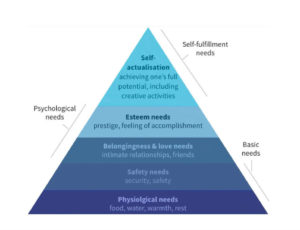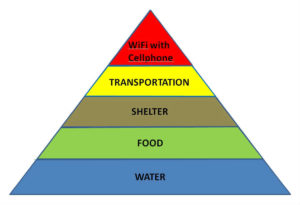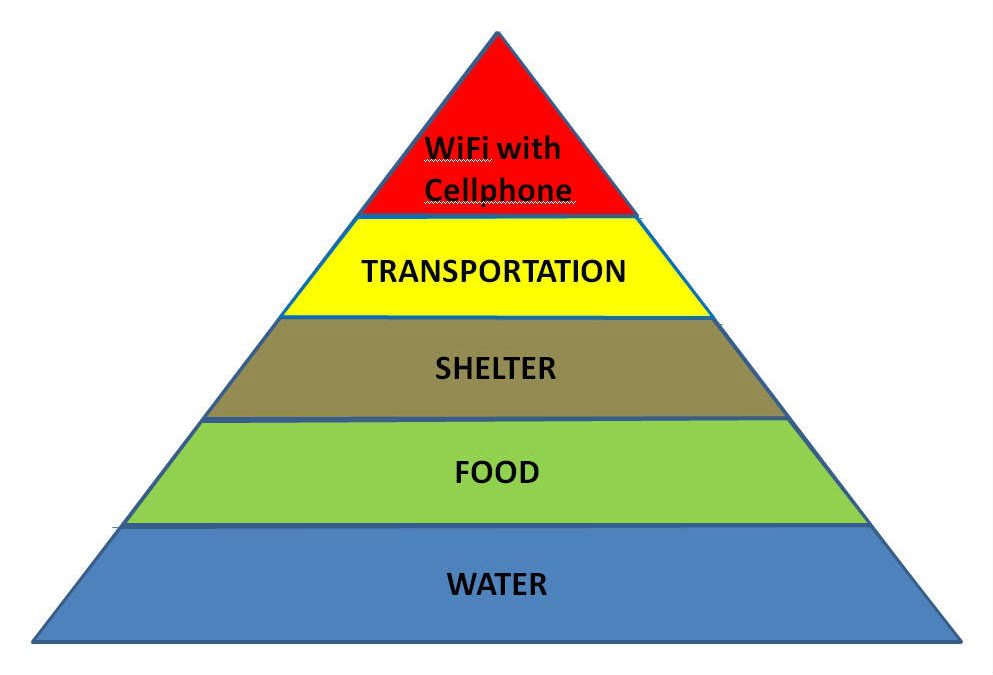What are the “must-haves” in life versus the “want-to-haves?” What are the most basic needs? “Must-haves” are something critical for survival. Without them, life would cease. Food and drinking water are “must-haves.” With no food or water, nothing else matters. Life isn’t even possible. Granted there are a few other things such as clothing and shelter that are almost as necessary, but don’t reach the “must-haves” category. Without food and potable water, survival chances are nil.

Hierarchy of Needs
Abraham Maslow’s Hierarchy of Needs, first published in the 1940’s, illustrates five steps of transformation beginning with the foundational layer being the “must-haves.” The needs of the triangle hierarchy increase four additional levels with the pinnacle being much more ethereal. Originally the theory intended completion of each step individually on the Hierarchy of Needs before moving to the next level. It is now generally accepted that a human may be at different levels of needs in varying aspects of one’s life.
The first layer of the Hierarchy of Needs are the most important basic human needs, the physiological essentials of food, drinking water, and shelter. These requirements for human existence are the foundational layer or perhaps the primal layer. The second tier of safety and security is important to developing a healthy, engaged, and functioning adult. Granted, a human can exist without safety and security, but will not likely function as well within societal expectations and norms. The first two layers could be consider the most basic needs. The third tier is psychological needs of emotional and well-being, encompassing relations and friendship. Knowing one belongs and dwells in community is important to one’s happiness. Ascending the hierarchy, the fourth step is a sense of esteem, respect, and admiration. The fifth tier, which is also the pinnacle of Maslow’s theory, is self-actualization or reaching one’s highest potential.
Moving up Maslow’s Hierarchy of Needs each tier is more enlightened, aspirational and comforting. Being a college educated white woman with advantage, I’ve seen Maslow’s tiered steps of needs as an objective or something to attain. Throughout my life, I’ve set a goal or intention on something to achieve and I’ve succeeded. Reaching goals and pinnacles are just part of my DNA. I graduated cum laude with civil engineering degree from a school that only six years before had started admitting women. As a mountaineer or more aptly a “peak-bagger,” I have climbed over 100 different Washington state mountain peaks. But now, the Hierarchy of Needs seems less stable and perhaps more uncertain now than it did earlier in my life.

Hierarchy of Needs with WiFi
When I googled Hierarchy of Needs, I gasped to see where popular culture has taken Maslow’s triangle. WiFi is now considered a foundational need below and supporting the physiological essentials of drinking water and food! WiFi, the ability to connect to anybody and everything worldwide and beyond, has become the most fundamental need! What are we becoming? A slave to our personal electronic device? Attached at birth from never missing the Tweet, the Snap, the Book or maybe even the beat of news? Are we so disconnected from our most primal needs of food and water, that we can’t fathom they could ever be threatened? Granted I’ve seen enough adults and teenagers panic when arriving at a remote mountain cabin in the Cascade Mountains or tent camp on the Serengeti Plain when there is no WiFi access. Has there ever been a consideration that lack of food or water would be even more devastating?
The plight of our basic human needs is ever more pressing. With the help of longevity, I am now an elder and an influencer–not an influencer of Instagram fame–but one with wisdom. In my lifetime, short by geological standards, still too young for Medicare but old enough for senior discounts, the disregard for our most basic needs of food and water is literally killing us. I see the urgency and the potential fragility of our destiny.
The Pyramid of Needs

The Pyramid of Needs
Rearranging the two lowest tiers of Maslow’s Hierarchy of Needs and adding a dose of engineering pragmatism, I created The Pyramid of Needs which are tangible services and goods that build a civilized, stable society. Food and drinking water are the most important needs in our lives. If we don’t have food and potable water, we don’t have human life or for that matter any life at all. Water is the most basic building block of life and is the foundational need. Freshwater is only 2.5% of the earth’s total water supply! Less than 1% of the total freshwater is available and accessible to drink, flush a toilet, take a shower, or water crops. (Some folks say we shouldn’t even be flushing toilets with potable water. We need more compost toilets or gray water systems!) The rest of the non-saline freshwater is frozen in glaciers and snowfields.
Making it more personal, the human body is about 60% water with our muscles being about 80% water and our bones just over a 30% water. Water nourishes our cells, carries nutrients through the body, flushes out toxins, keeps our joints moving and is the “shock absorber for our brain and spinal cord.” Without water, we would very uncomfortable within a short 24 hours and dead in a couple days. Water is essential to our well-being.
While not quite as critical as water, food as the second tier in the Pyramid of Needs is almost just as important to one’s well-being. Living on water alone is impossible, as we are reliant on food, too, but we can live longer without food. Mahatma Gandhi, a leader who advocated for India’s independence using non-violent means, survived three weeks with no food and only sips of water to sustain his body. Hence, food and water are the basic building blocks of life and the first two layers of The Pyramid of Needs.
Shelter and transportation, as third and fourth tier requirements, are still basic needs in today’s economy, but still less essential than food and water. Shelter is necessary to keep us warm, dry, fed, and cleansed. Transportation, whether by foot, bike, bus, rail, car, boat, or air, is vital to create a thriving economy. Putting WiFi and the personal cellular computer device at the pyramid’s apex, just makes sense, as they are needed the least for one’s well-being. Yes, it is a huge disadvantage to potential employment opportunities and even happiness in the United States to live without a personal mobile computing device. However, it is doable to live without it!
So why does our U.S. culture focus so much of our finances and attention on WiFi and the newest cellular product? Why is scant attention directed to where our food comes from food or the cleanliness of the water we put in our bodies? The best cellphone, car or perhaps the most expensive handbag or sneaker seem so much more important than quality food and water. The body that lives with each one of us 24-hours every day of every week and every year, our most sacred temple, needs fresh, clean, healthy food and water to survive and thrive!
Instead, U.S. culture fills our body with junk food and sugary drinks while simultaneously taking a robust healthy food and water supply for granted. We swiftly dismiss our most basic needs, when our food and water systems genuinely need our attention and focus to ensure the long term viability of these systems. Instead of a robust, secure, and healthy drinking water and food systems, I see fragility. Hence, my hierarchy is aptly called The Unstable Pyramid of Needs.
The Unstable Pyramid of Needs

The Unstable Pyramid of Needs
Trust and confidence that the United States has the most reliable, clean, safest water systems in the world is expected. However, our drinking water systems are fragile and unstable as depicted by the holes in the foundational tier of The Unstable Pyramid of Needs. It is a house of cards ready and waiting to fail. The Flint, Michigan water supply fiasco is emblematic of this fragility. To reduce costs, because of the City of Flint’s financial hardship, the drinking water supply source was switched from Lake Huron and the Detroit River to a cheaper but more corrosive supply the Flint River. The Flint River water supply serving the City caused lead corrosion from the aging water pipe infrastructure. Consequently, between 6,000 to 12,000 Flint’s children were exposed to high levels of lead which can cause long term developmental delays and learning disabilities. Children never recover from lead poisoning! Hazards of lead poisoning in young children has been known for more than 50 years, triggering regulation and elimination of lead in paint and children’s toys. This Flint crisis is just one example why the American Society of Civil Engineer’s Drinking Water Report Card, gave a “D” letter grade for below average conditions of the United States’ drinking water systems. Our country’s drinking water systems are vulnerable and need attention and investment to maintain high quality, reliable potable water!

A New Development on the Edge of a Former Orange Grove
The second tier on The Unstable Pyramid of Needs is our food supply. Elimination of farmlands and replacement with housing, roads and warehouses is all too common. We sacrifice food growing lands for soccer fields and parks, too! Farmland, once lost, does not return to food production. Between 1992 and 2012, in a short 20 years, about 31 million acres of farmland, about the size of Mississippi, was lost to real estate development in the United States per the American Farmland Trust. About 10 million of the 31 million acres lost were considered premier agricultural lands with the best soils, weather, and growing conditions for food production. This is equivalent of losing 175 acres per hour or 9 acres per minute. According to the same source, 91% of the fruit trees, tree nuts, and berries are in the path of development in the counties and metropolitan areas most threatened by suburbanization and urbanization. Think orange groves in Florida. In 2015, 50,000 acres of farmland were lost in Florida alone! The food tier, too, is fragile, riddled with holes and unstable.
Our food and drinking water resources are being ignored and being taken for granted. They are “must-haves” for our survival and well-being. We must not short-shrift these important needs. When farmland is proposed for conversion to non-food production uses or drinking water supplies are threatened or budgeting decisions are being made on how to spend public dollars, it is imperative to prioritize our food and water supply infrastructure.
The Unstable Needs Pyramid are tangible needs one can hold, touch, feel and use. The bottom two layers are our most basic needs: water and food. Investment and political will-power is needed to enhance and protect our country’s food supply and water infrastructure. Our lives depend on it. Really.
Kathryn Gardow, P.E., is a local food advocate, land use expert and owner of Gardow Consulting, LLC, an organization dedicated to providing multidisciplinary solutions to building sustainable communities. Kathryn has expertise in project management, planning, farmland conservation, and civil engineering, with an emphasis on creating communities that include food production. Kathryn’s blog muses on ways to create a more sustainable world and good food!

